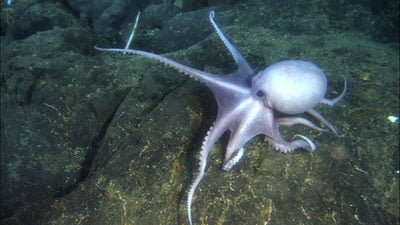Aliens of the Deep

Observing that his deep sea explorations felt akin to traveling to outer space, director James Cameron ("Ghosts of the Abyss," "Titanic") suggested that the two scientific branches work together. His proposal was met with great enthusiasm and a team of marine biologists, geologists and astrobiologists banded together to search for "Aliens of the Deep."
Laura's Review: B+
Cameron's latest 3-D IMAX presentation takes his audience on a journey to witness sights few, if any, have seen. At first, we're wowed by the 3D experience - kids under a water sprinkler, people on a dance floor - before the montage clarifies the subject. An unsubtle edit juxtaposes a young cow with a kid biting into a juicy burger, herbivore and carnivore represented in two quick shots. One last concession to 3-D has an elephant's trunk coming out to grab us before we segue into the exploration, introduced with narration by PhD graduate student Djanna Figueroa, a marine biologist who explains how the food chain is solar powered, beginning with the photosynthesis necessary for plant life. This is the fact that "Aliens of the Deep" will blow apart. The young men and women assembled by Cameron were chosen for their passion and communicative skills, but it's obvious that an adventurous spirit is also a requirement. The bubble technology used to travel to depths measured in miles under several thousand pounds of pressure resembles space ships and is the only thing separating the scientists from being crushed to death. Several sites are visited, in both the Atlantic and Pacific Oceans (the documentary makes identification difficult, providing only longitudes and latitudes). Initially the filmmakers concentrate on showcasing the wondrous creatures they found - a glowing cross between octopus and starfish with appendages like ears or wings, a giant squid, a reticulated jelly-like, circular ribbon encasing an unknown animal. Then they focus in on their central presentation, the hydrothermal vent sites, where cracks in the earth's crust allow boiling, mineral rich water and lava into the near freezing ocean. Marine seismologist Maya Tolstoy explains these phenomena as we get a look at the formations made, towering 'chimneys' which spout superheated water that looks like black smoke. At another, similar, site, Figueroa returns to marvel at the swarms of blind, white shrimp which live in this extreme environment - without sunlight. Chemosynthesis proves that life is possible with water, warmth and minerals. Now scientists believe they may find life under the frozen surface of Europa, one of Jupiter's moons. In the final chapter, Cameron's science fiction background comes into play as he visually 'imagines' the technology which may make exploration of Europa's hidden seas possible. The director gives Djanna her own ET encounter, when he pairs the scientist with imagined creatures that might be found there. The 3-D IMAX presentation is startlingly vivid. Although the combination of images and the glasses which must be worn for the effect sometimes induce a little eye crossing, more frequently they make the audience believe it can reach out and touch the things in front of them. The dialogue, which is supposed to sound spontaneous, does come off as scripted, but explanations are clear and the narrators' enthusiasm is infectious. Lots of 'awesomes' escape from the mouths of these people, who exhibit giddy pleasure in the jobs they feel lucky to have. Kudos as well to Cameron, who looks mighty good featuring a two to one ratio of female to male scientists less than two weeks after Harvard University's president made headlines for incendiary comments on the subject of women in science and engineering. Unlike Cameron's previous IMAX documentary, the feature length "Ghosts of the Abyss," "Aliens of the Deep" runs just under fifty minutes. It presents complex ideas simply with amazing visuals to wow those from eight to eighty.
Robin's Review: DNS
DNS

